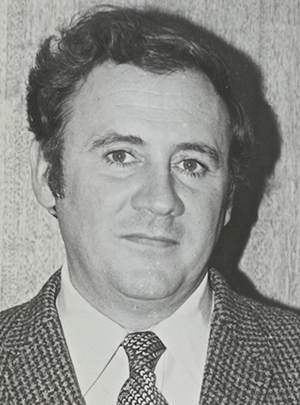
Dr. Robert Carovillano, an internationally recognized theoretical space physicist and inspiring teacher and mentor of numerous undergraduate and graduate students, died suddenly on 15 October 2015 in Delray Beach, Fla. He was 83 years old.
He received his B.S. degree from Rutgers University and M.S. and Ph.D. degrees in theoretical physics from Indiana University. His thesis was on the theory of the nuclear force, and his early publications were in nuclear physics and quantum field theory. He joined the Boston College (BC) faculty as an assistant professor of physics in 1959 and chaired the Department of Physics from 1969 to 1982. He played a leadership role in establishing the doctoral program in physics and founding the university chapters of Phi Beta Kappa and Sigma Xi.
Devoted Teacher and Mentor
He was a natural and popular teacher and while at BC taught seven different courses for nonscience majors, 11 different courses for science majors, and 11 different courses for graduate physics students. He retired from Boston College in 2003, having supervised 15 doctoral students.
Jack Maguire was one of his early doctoral students and had this to say:
“I have been blessed with scores of great teachers at both BC High and Boston College. But Bob Carovillano was by far the best I have ever known.”
“I have been blessed with scores of great teachers at both BC High and Boston College. But Bob Carovillano was by far the best I have ever known. He was brilliant, demanding, and empathetic. The dedication of my doctoral thesis 50 years ago stands as my tribute to a man with the looks of Elvis and the brain of an Einstein: ‘To Professor Robert L. Carovillano—my teacher, mentor, and friend—who gave unstintingly of himself in an oftentimes heroic endeavor to make me a better physicist…I dedicate this thesis.’”
Bob was the son of first-generation Italian immigrants and the first in his family to attend college. He overcame infantile paralysis (polio) to become an enthusiastic squash and tennis player for decades. He was an avid “armchair athlete” for his entire adult life and rooted for the Yankees, the Red Sox, the Giants, and the Patriots with equal gusto. His stories of playing stickball in the streets of Newark, N.J., as a child and watching the Yankee greats were captivating to his family and friends.
Focus on Magnetospheric and Space Physics
In the mid-1960s Bob’s research interest moved to magnetospheric and space physics, and he published on a broad spectrum of topics in theory and data analysis. These include magnetospheric energy theorems, magnetosphere-ionosphere coupling processes, substorm modeling, ionospheric electric fields and currents, ring current and radiation belt energetics and dynamics, hydromagnetic waves and plasma resonances, solar wind propagation and structure, and analysis of satellite measurements and auroral images.
He built up the space science program at Boston College in the years 1965–1980s despite stringent limitations on faculty hiring. His political acumen enabled the creation of a research core of research professors and visiting professors. He organized one of the earliest international conferences at Boston College on “The Physics of the Magnetosphere” (1968) and an international symposium on “Science and the Future of Man” (1971).
He collaborated with numerous scientists in the field and at various times was a visiting professor at the Massachusetts Institute of Technology, the University of California, Los Angeles, and the University of Colorado Boulder.
Bob served on and sometimes chaired numerous advisory committees for the National Academy of Sciences, the National Center for Atmospheric Research, and the National Science Foundation. He was a member of NASA’s Space Science Advisory Committee and reviewed numerous space shuttle and satellite projects. As an officer and trustee of the Universities Space Research Association, he twice served as chairman of the Council of Institutions. In 1982–1984 he was liaison scientist at the Office of Naval Research, London (U.K.) office.
Making a Mark at NASA
He went on to serve as a visiting senior scientist at NASA Headquarters in the Office of Space Science, where he was responsible for supervising several space physics programs and research initiatives. Here he coordinated the various missions in the International Solar-Terrestrial Physics program and maximized their combined scientific output. In particular, his efforts nurtured data sharing and the development of coordinated analysis tools. He worked adroitly, and successfully, with his advisory committees to achieve and implement the goals of the entire heliospheric science community.
Bob also served in various capacities at the American Geophysical Union: secretary of Magnetospheric Physics and Solar-Planetary Relations, 1970–1976; section chairman of Magnetospheric Physics on numerous occasions; and member (1974–1975) and chairman (1977–1978) of the Meetings Committee. Bob cofounded the Chapman Conferences, an ongoing series of small, topical meetings that has grown into a major part of AGU’s meetings program.
Despite an illustrious academic career, he considered his greatest accomplishment to be his children.
Vociferous in his opinions, charming, handsome, and proud, he was the very embodiment of the supposition that any obstacle can be overcome, given hard work and determination. Despite an illustrious academic career, he considered his greatest accomplishment to be his three children (Deborah, David, and Rebecca), eight grandchildren, and three great-grandchildren, of whom he was immensely proud. He was predeceased by his wife, Mary Ann, to whom he was married for more than 30 years.
—Robert Eather, Keo Consultants, Brookline, Mass.; email: [email protected]; Jack Maguire, Maguire Associates, Concord, Mass.; and Rebecca Carovillano, CH2M Environment and Nuclear Business Group, Philadelphia, Pa.
Citation: Eather, R., J. Maguire, and R. Carovillano (2016), Robert L. “Bob” Carovillano (1932–2015), Eos, 97, doi:10.1029/2016EO052331. Published on 16 May 2016.
Text © 2016. The authors. CC BY-NC-ND 3.0
Except where otherwise noted, images are subject to copyright. Any reuse without express permission from the copyright owner is prohibited.
